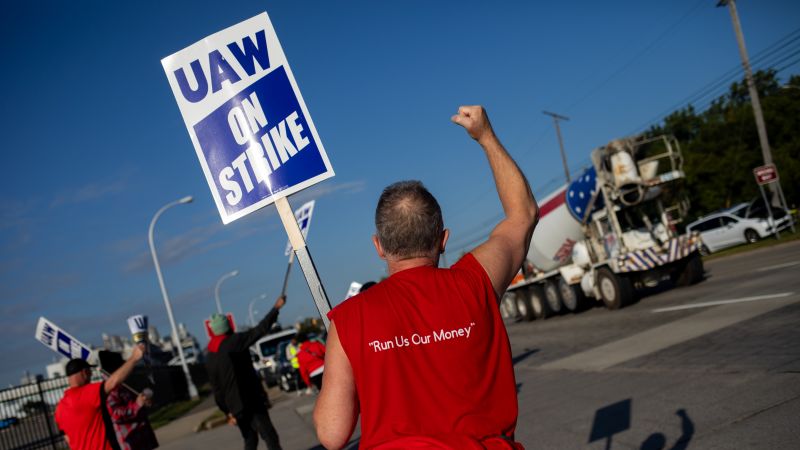New York
CNN
—
With the United Auto Workers’ historic strike officially underway, experts say the US economy is already getting bruised – but the strike’s impact isn’t likely to push the nation into a recession.
“That’s because the unionized part of the industry, while still large, is not as big a piece of the national economy as it once was,” Gabriel Ehrlich, an economic forecaster at the University of Michigan, told CNN.
But the ultimate impact of the strike depends on things like how long the strike lasts, if companies lay off workers at other plants, how many workers walk off their jobs and how long the unions and companies take to negotiate a deal.
UAW president Shawn Fain said “we’re not going to wreck the economy. The truth is we are going to wreck the billionaire economy.”
And while estimates of the economic impact of the strike don’t point at “wrecking the economy,” the damage could be significant.
For instance, if all UAW workers at Ford, General Motors and Stellantis strike for 10 days, it would cost the US economy $5 billion, according to Anderson Economic Group’s estimates.
Another estimate by Ehrlich assumes there would be a much smaller immediate spillover effect. He estimated $440 million worth of income would be lost nationally if all the UAW members strike for two weeks. If the strike lasts eight weeks, he estimates a $9.1 billion hit to incomes nationwide.
Here are the ways the US economy could get hurt by the strike:
Although striking UAW members will be receiving $500 a week in strike pay, it likely won’t be sufficient for them to keep up their normal spending. That means local businesses near strike sites will lose out on revenue.
If the strike goes on long enough, it could lead employers near the affected auto plants to lay off workers, said Tyler Theile, vice president and director of public policy at Anderson Economic Group.
Because car inventories nationally are still below pre-pandemic levels, the Big Three automakers are going to be anxious to restart production as soon as the strike ends, said Ehrlich. That’s why he expects them to delay canceling orders with suppliers for necessary parts for as long as possible.
But when the automakers ultimately do begin canceling orders, it will have a ripple effect throughout the parts supplier network. At first, suppliers who work directly with the automakers, so-called tier one suppliers, will try to keep workers on the payroll because they’re worried about being able to rehire if they let people go, in what’s called “waiver hoarding behavior.”
But if a strike goes on long enough, they’ll have no choice but to lay off workers.
Then the pain may spread. Tier two suppliers -— those that supply the tier one businesses — could also have to lay off workers as a result.
Fewer people working because of the strikes will mean the government can’t collect as much tax revenue. That matters because it means that fewer programs will receive the funds they need.
At the state level, Ehrlich estimated that Michigan, the epicenter of many of the strikes, will see a $10.6 million decline in tax revenue if the strike lasts two weeks.
Anderson Economic Group estimated that 25,000 vehicles won’t be produced if the strike lasts 10 days. That would lead to higher car prices, especially since inventory is tight as is, said Theile.
Still, the strike’s impact will be nothing like the Covid pandemic and the computer chip shortages that largely shut down the entire US auto industry in recent years, said Jonathan Smoke, chief economist for Cox Automotive.
As it stands, prices for new vehicles are up almost 3% from last year, according to the August Consumer Price Index.
CNN’s Peter Valdes-Dapena contributed.
Sumber: www.cnn.com






